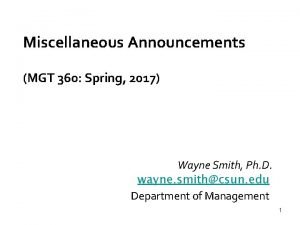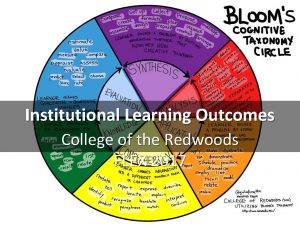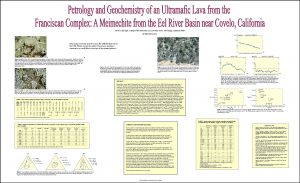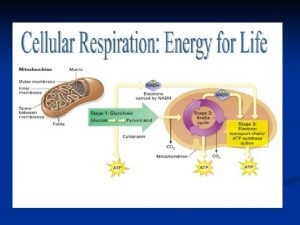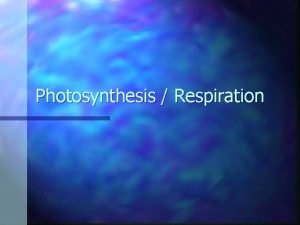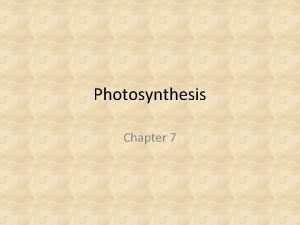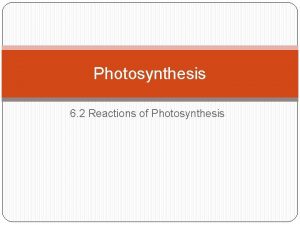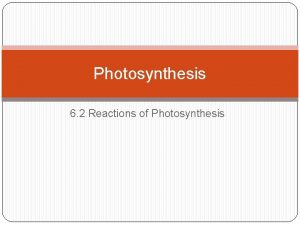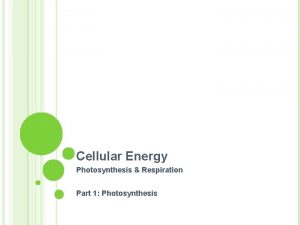Photosynthesis Anderson Spring 2017 College of the Redwoods



























- Slides: 27

Photosynthesis Anderson Spring 2017 College of the Redwoods

How do plants get energy? Cellular Respiration C 6 H 12 O 6 sugar Photosynthesis + 6 O 2 oxygen 6 CO 2 + 6 H 2 O carbon dioxide water 6 CO 2 + 6 H 2 O + ATP carbon dioxide light water C 6 H 12 O 6 sugar energy + 6 O 2 oxygen

Autotroph/Heterotroph • Autotroph – organism that produces its own food • auto = self, troph = feeder • Plants (and some bacteria and algae) are photoautotrophs uses sunlight and carbon from CO 2 to synthesize energy • Heterotroph – organisms that must obtain energy and carbon from food by consuming other organisms • hetero = other, troph = feeder • Dependent on autotrophs

Leaf Cross-Section Photosynthesis occurs in the mesophyll (middle layer) CO 2 exchange happens through openings on bottom of leaf, called stomata

Chloroplasts Organelle in which photosynthesis takes place • Thylakoid – membrane-bound disc structure that contains chlorophyll (green) • Granum – stack of thylakoids • Stroma – space around granum

What is Light Energy? • Longer wavelengths carry less energy; shorter carry more • Sunlight emits broad range of electromagnetic radiation

Visible Light Spectrum • White light – light that contains all wavelengths of light • The colors we see are the light that’s NOT absorbed • When we see green, all light except for green is being absorbed

Chlorophyll Pigments • Chlorophyll a – absorbs from violet and red range • Chlorophyll b – absorbs from blue and red-orange • Carotenoid – absorbs from bluegreen (looks red, orange, yellow) • Not all plants are equal! (but all plant lives matter)

Photons • Individual bundles of electromagnetic energy • Can provide energy to electrons (makes them move) • Basic unit of all light

Structure of Chlorophyll

Let’s tie all that nonsense together • Plants make their own food from sunlight energy – photoautotrophs • Sunlight contains tiny particles, called photons, that make up light • These photons have energy! • The photons in the light hit the chlorophyll pigments in plant leaves, green light is reflected, all other absorbed • A reaction occurs which is the

Stages of Photosynthesis • Stage 1 – Light Reactions • Energy from sun light splits water to produce oxygen • Reduces NADP+ to NADPH, which will then carry high energy electrons to Calvin Cycle • Stage 2: Calvin Cycle • Carbon dioxide and the high energy electrons from NADPH are used to create carbohydrates (glucose) • Called the “dark cycle” because sunlight is not necessary

Light-Dependent Reactions • Photosystem – grouping of pigment molecules (chlorophyll) and proteins • Exists in thylakoid membrane • Photon is “absorbed” by the chlorophyll and causes chlorophyll to become excited • The electron breaks free from chlorophyll – “donates” electron • The electron must be replaced – this is done by splitting water into oxygen and hydrogen ions (each water molecule releases 2 electrons) H 2 O ½ O 2 + 2 H+

Photosystems • In eukaryotes and some prokaryotes, there’s 2 photosystems: • Photosystem II and Photosystem I (named by discovery, not order of function)

Photosystem II 1. Light energy absorbed and enters reaction center – chlorophyll excited 2. Electron captured by acceptor 3. Water split, electrons replace donated ones from chlorophyll, O 2 released as byproduct 4. Electrons are passed to photosystem I

Photosystem I 5. Once electrons re passed to photosystem I, electrons are captured by acceptor 6. Excited electrons oxidize NADP+ to NADPH (another energy storing molecule)

ATP Synthase • Electrochemical gradient of H+ ions created through electron transport chain • ATP synthase uses gradient to diffuse H+ out of thylakoid space

End Result of Light-Dependent 2 H 2 O 2 O 2 + 2 H 2 – oxygen is the byproduct 1 NADPH 1 ATP So where does the carbon come from to make the glucose?

Calvin Cycle • Reactions of photosynthesis that use energy stored from light-dependent reactions (ATP and NADPH) to form glucose • CO 2 enters chloroplasts by diffusion (enters cell through stomata) • Calvin cycle occurs in stroma (space between membrane and thylakoids) • In addition to CO 2, Ru. Bis. CO (an enzyme), and Ru. BP (5 carbon molecule) are needed

Calvin Cycle Stage 1: • Carbon fixation – CO 2 and Ru. BP (5 carbons) create 6 carbon compound, catalyzed by Ru. Bis. CO • The 6 -carbon compound immediately breaks into 2 3 -carbon compounds (3 PGA)

Calvin Cycle Stage 2: • 3 -PGA (3 -carbon molecule) reduced by NADPH and ATP • Results in G 3 P, NADP+ and ADP • 1 ATP and 1 NADPH used for each 3 -PGA molecule • 1 G 3 P leaves cycle to make glucose

Calvin Cycle Stage 3: • Remaining G 3 P molecules regenerate Ru. BP (5 3 -carbon molecules rearrange to make 3 5 -carbon molecules) • 3 more ATP used, making 3 ADP • And the cycle is ready for the next CO 2 • Takes 6 turns to make 1 glucose (or 2 with 3 CO 2 to start)

How do prokaryotes do it without chloroplasts? • Remember: prokaryotes lack membrane-bound organelles, such as chloroplasts • Prokaryotic photosynthetic autotropic organisms have infoldings of plasma membrane for chlorophyll attachment and photosynthesis

One organism’s waste is another organism’s energy • Carbon dioxide is “waste” for animals, plants need carbon dioxide for photosynthesis • Oxygen is “waste” for plants, animals need oxygen for cellular respiration 6 CO 2 + 6 H 2 O carbon dioxide water C 6 H 12 O 6 + 6 O 2 sugar oxygen C 6 H 12 O 6 sugar + 6 O 2 oxygen 6 CO 2 + 6 H 2 O carbon dioxide water

Plants Undergo Cellular Respiration Too! • Carbohydrates are energy storage molecules • Plants store their glucose as starch • The ATP from the light-reactions of photosynthesis is enough to fuel the Calvin cycle, not the whole plant cell • Plants have mitochondria too! Cellular respiration provides more ATP • When there’s little or no light, plants get their energy from cellular respiration (take in O 2 and release CO 2)

Do Plants Sleep? • During the night, when there’s no sunlight, plants consume oxygen to undergo cellular respiration (use their carbohydrate energy stores) • They will be using oxygen and releasing CO 2, just like we do • But! Plants take up much more CO 2 during photosynthesis than they release at night • So the next time a 5 year old asks you this question, you can tell them, “No, they don’t really sleep. They’re just doing other things at night that they don’t do during the day. ”

Don’t listen to our President, global warming is real!
 Csun spring 2017
Csun spring 2017 Ftp server spring 2017
Ftp server spring 2017 Spring summer fall winter and spring cast
Spring summer fall winter and spring cast Autumn winter summer
Autumn winter summer Hát kết hợp bộ gõ cơ thể
Hát kết hợp bộ gõ cơ thể Lp html
Lp html Bổ thể
Bổ thể Tỉ lệ cơ thể trẻ em
Tỉ lệ cơ thể trẻ em Voi kéo gỗ như thế nào
Voi kéo gỗ như thế nào Tư thế worm breton là gì
Tư thế worm breton là gì Bài hát chúa yêu trần thế alleluia
Bài hát chúa yêu trần thế alleluia Các môn thể thao bắt đầu bằng tiếng nhảy
Các môn thể thao bắt đầu bằng tiếng nhảy Thế nào là hệ số cao nhất
Thế nào là hệ số cao nhất Các châu lục và đại dương trên thế giới
Các châu lục và đại dương trên thế giới Công thức tính độ biến thiên đông lượng
Công thức tính độ biến thiên đông lượng Trời xanh đây là của chúng ta thể thơ
Trời xanh đây là của chúng ta thể thơ Mật thư anh em như thể tay chân
Mật thư anh em như thể tay chân Làm thế nào để 102-1=99
Làm thế nào để 102-1=99 Phản ứng thế ankan
Phản ứng thế ankan Các châu lục và đại dương trên thế giới
Các châu lục và đại dương trên thế giới Thơ thất ngôn tứ tuyệt đường luật
Thơ thất ngôn tứ tuyệt đường luật Quá trình desamine hóa có thể tạo ra
Quá trình desamine hóa có thể tạo ra Một số thể thơ truyền thống
Một số thể thơ truyền thống Cái miệng nó xinh thế chỉ nói điều hay thôi
Cái miệng nó xinh thế chỉ nói điều hay thôi Vẽ hình chiếu vuông góc của vật thể sau
Vẽ hình chiếu vuông góc của vật thể sau Thế nào là sự mỏi cơ
Thế nào là sự mỏi cơ đặc điểm cơ thể của người tối cổ
đặc điểm cơ thể của người tối cổ Thứ tự các dấu thăng giáng ở hóa biểu
Thứ tự các dấu thăng giáng ở hóa biểu
